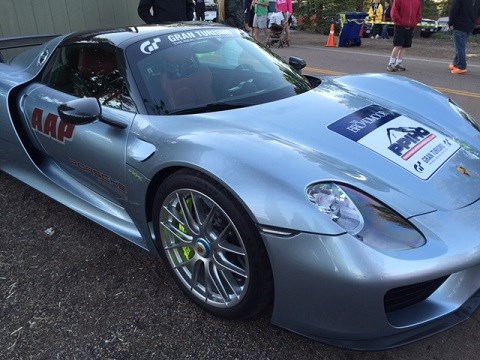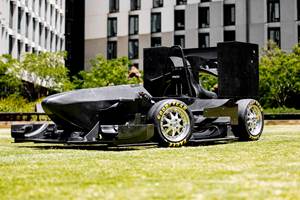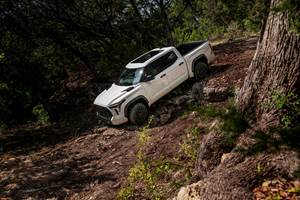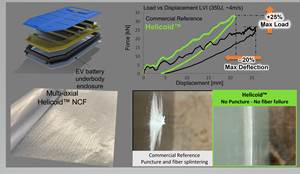Carbon in the cloud(s)
Carbon is the norm, and even a necessity, at the Pikes Peak International Hill Climb race event, held June 28.

An electric race car from Tajima Motor Corp. has an all-carbon composite body and floor. Driven by "Monster" Tajima, it placed second overall in the Pikes Peak International Hill Climb.

My nephew James Robinson's Acura NSX with carbon fiber body, just before his run up the mountain.
I’ve just been writing an article about composite materials for mass production cars (coming in the September issue) and the issues involved in convincing OEMs that composites bring the right value proposition. But, in the midst of that, I got the chance to participate in a motorsports event where carbon fiber composites are the norm, even a necessity, and not the exception: the Pikes Peak International Hill Climb.
Full disclosure: I come from a racing-obsessed family. My Dad, an electrical engineer and sports car enthusiast, used to make extra money fixing those “foreign” jobs during the 50s and 60s that no one else would touch. With Jaguars, MGs, a Morgan and the odd Citroen in the driveway at various times, and our proximity to Watkins Glen, NY and the formula races there, it’s no wonder that Dad, my brother and I eventually wound up racing vintage cars.
Fast forward to the present: my nephews are now all employed by Honda R&D Americas (Raymond, OH, US), and involved in chassis, suspension and engine development for new models, as well as test driving for the company. James Robinson, with a history of rally racing, decided several years ago to bring Honda to the Pikes Peak International Hill Climb, held each year since 1916 on Pike’s Peak near Colorado Springs, CO, US. The objective is to ascend from the start line (at 2889m above sea level) to the 4342m summit on the two-lane paved highway, and negotiate the 156 corners as fast as possible. Check out the official race video on the PPIHC home page: www.ppihc.com . His brother, Nick Robinson, has lapped the Nurburgring thousands of times during car testing, and he competed at Pikes Peak (and won his class) on a Honda 250 motorcycle.
Over the past three years, Honda’s participation has grown from a few competitors to over 20 cars, motorcycles and four-wheelers. This year a carbon-fiber-bodied 2015 Acura NSX supercar was the designated event pace car (photos of the prototype NSX pace car here: http://www.acura.com/FutureVehiclesNSX.aspx; a link to a Motor Trend magazine review of the modern NSX: http://www.motortrend.com/future/future_vehicles/1204_2015_acura_nsx/ ; and a photo of the NSX pace car at the Pike’s Peak summit, waiting for all competitors to finish: http://shop.randelsmediagroup.com/p329835694/h4caa68e7#h4cd0a577). As you can see, the weather at the mountain’s summit is a bit of a challenge (it was about 85° at the start line). That pace car was one of several dozen testing prototypes produced by Honda, but James Robinson says that actual production cars will not be all-carbon but will be made using a combination of carbon, steel and aluminum in a multi-material approach. Check out this video of the pace car's run up the mountain: https://www.youtube.com/watch?v=mKnBDVgZqc0&feature=youtu.be.
A big attraction was the all-electric, carbon-bodied race car with an aluminum chassis built by Tajima Motor Corp. (Tokyo, Japan) and entered as part of the Assn. for the Promotion of Electric Vehicles (APEV). Dubbed the Tajima Rimac E-Runner Concept One, the car was piloted by the head of Tajima Motor Corp, Nobuhiro “Monster” Tajima, a long-time competitor at the event. Due to a mechanical brake failure, Tajima wasn’t the fastest up the mountain, but still managed second place overall, after another electric car. Team APEV crew members told CW that all of the bodywork and the car’s floor panels were fabricated via hand layup and autoclave cure by Monarte, a Tajima subsidiary, using Toho Tenax carbon/epoxy prepreg. Here’s a CW news item about the Team APEV car: http://www.compositesworld.com/news/toho-tenaxs-prepreg-used-in-electric-racecar-.

A carbon fiber-intensive Porsche 918 Spyder supercar was the even'ts second pace car.
Another head-turning entry was a Porsche 918 Spyder supercar piloted by Sheikh Khalid bin Hamad Al-Thani of Qatar (with Qatari plates, and flown in to Colorado). The virtually all-carbon hybrid, with a carbon/epoxy passenger tub and crash structures, produces insane power and speed with a mid-engine V8 coupled with two electric motors. The Sheikh offered a simple explanation to the Colorado Springs Gazette as to why he took on the risk of the hill climb: “I just love racing.” Designated as the second pace car, the Porsche clocked a time of 11 minutes, 37 seconds.
My nephew James Robinson’s car is an original, mid-engined Acura NSX from the 1990s, and is a race-specific version (two such cars were produced) with a carbon fiber body, originally intended for the Le Mans, France endurance race. Modified for the hill climb with a wing, the car and driver managed a second overall in the Open class, with a 10:37 time.
I guess the point here, other than the fact that I got to spend an awesome day at one of the 10 best race events in the world, is that carbon fiber composites have a solid position in motorsports, due to the fact their low weight provides a higher power to weight ratio, which gives you a better chance of winning, and that’s worth the cost of the material. If you’re interested in what it’s like to drive up Pikes Peak, from a driver’s point of view, watch the following video from my nephew’s in-car GoPro camera.
A few notes: you may think the video is distorted or faulty, but you’re seeing the Lexan windshield flexing in the wind at higher speeds. Plus, the noises you’ll notice that sound like gravel are the car’s rear carbon fiber splitter hitting the ground on a few corners. It’s long, but provides a taste of the race to the clouds, in a carbon composite race car (turn up the volume!).
Related Content
Protecting EV motors more efficiently
Motors for electric vehicles are expected to benefit from Trelleborg’s thermoplastic composite rotor sleeve design, which advances materials and processes to produce a lightweight, energy-efficient component.
Read MoreMonash Motorsport constructs FSAE autonomous, electric vehicle with ATL Composites materials
Composite are incorporated into the vehicle’s monocoque chassis, aerofoils, aerofoil endplates and other components to suit high aerodynamic loads, minimize mass and enhance efficiency for the globally competitive team.
Read MoreSeat frame demonstrates next-generation autocomposites design
Light weight, simplified/cost-effective manufacturing, passenger comfort and safety informed materials and process innovations and won awards for the 2022 Toyota Tundra‘s second-row seat frame.
Read MoreHelicoid Industries releases three use cases of Helicoid technology
Use case applications with Helicoid technology implementation demonstrated mechanical performance improvements, such as impact resistance and strength.
Read MoreRead Next
From the CW Archives: The tale of the thermoplastic cryotank
In 2006, guest columnist Bob Hartunian related the story of his efforts two decades prior, while at McDonnell Douglas, to develop a thermoplastic composite crytank for hydrogen storage. He learned a lot of lessons.
Read MoreComposites end markets: Energy (2024)
Composites are used widely in oil/gas, wind and other renewable energy applications. Despite market challenges, growth potential and innovation for composites continue.
Read MoreCW’s 2024 Top Shops survey offers new approach to benchmarking
Respondents that complete the survey by April 30, 2024, have the chance to be recognized as an honoree.
Read More

























